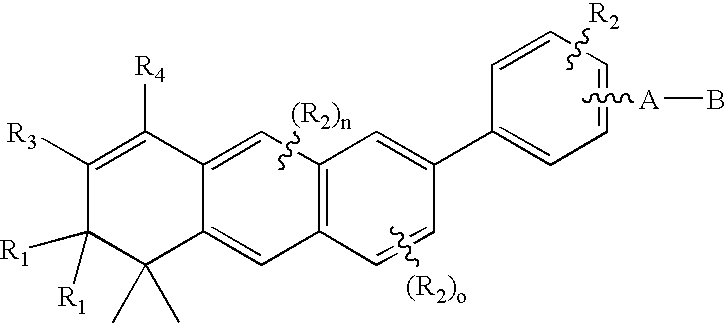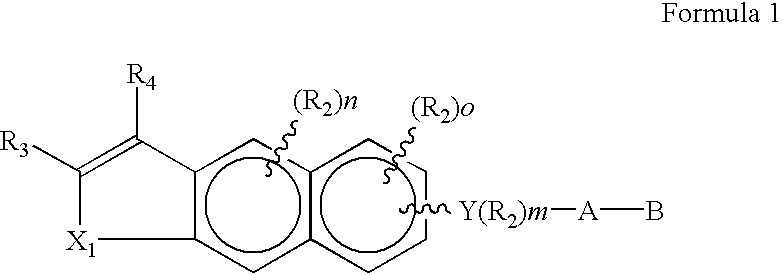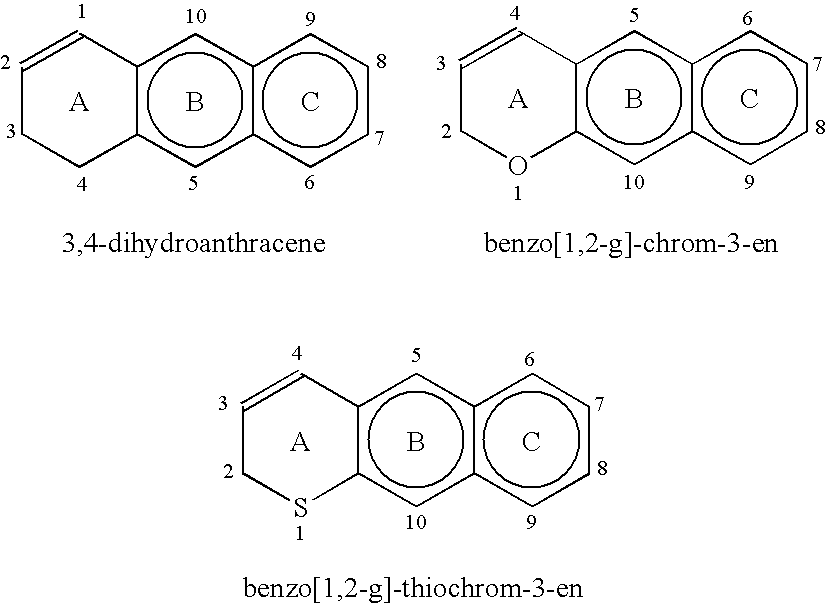Aryl substituted 3,4-dihydroanthracene derivatives having retinoid antagonist or retinoid inverse agonist type biological activity
a technology of aryl or heteroaryl and dihydroanthracene, which is applied in the field of compounds having retinoidlike, retinoid antagonist and/or retinoid inverse agonistlike biological activity, can solve the problems of limiting the acceptability and utility of retinoids for treating diseases, the undesired side effects of retinoids, etc., to prevent the undesired effects of certain retinoid agonists, prevent the undesintended side effect o
- Summary
- Abstract
- Description
- Claims
- Application Information
AI Technical Summary
Benefits of technology
Problems solved by technology
Method used
Image
Examples
specific embodiments
[0075]With reference to-the symbol Y in Formula 1, the preferred compounds of the invention are those where Y is phenyl, naphthyl, pyridyl, thienyl or furyl. Even more preferred are compounds where Y is phenyl. As far as substititutions on the Y (phenyl) and Y (pyridyl) groups are concerned, compounds are preferred where the phenyl group is 1,4 para) substituted and where the pyridine ring is 2,5 substituted. (Substitution in the 2,5 positions in the “pyridine” nomenclature corresponds to substitution in the 6-position in the “nicotinic acid” nomenclature.) In the presently preferred compounds of the invention there is no R2 substituent on the Y group.
[0076]The A-B group of the preferred compounds is (CH2)qCOOH or (CH2)q—COOR8, where R8 is defined as above. Even more preferably q is zero and R8 is lower alkyl.
[0077]The aromatic carbocyclic portions (B and C rings) of the 3,4-dihydroanthracene moiety, or of the benzo[1,2-g]-chrom-3-ene, benzo[1,2-g]-thiochrom-3-ene and benzo[1,2-g]-1...
specific examples
1-(Tol-4-yl)3,4-dihydro-4,4-dimethyl-7-bromo-naphthalene (Compound B)
[0104]To a mixture of Mg metal (650 mg, 27 mmol) in THF (20 mL) was added 4-bromotoluene (5.3 g, 31 mmol) in THF (40 mL). The mixture was stirred for 2 hours at ambient temperature and heated to 70° C. for 30 minutes. After cooling to ambient temperature, 3,4-dihydro-4,4-dimethyl-7-bromo-1(2H)-naphthalenone (Compound A) (2.1 g, 8 mmol), in THF (5 mL) was added and heated to 70° C. for 24 hours. The mixture was cooled to ambient temperature and the reaction was quenched by addition of H2O. The mixture was diluted with ether:ethylacetate (1:1, 100 mL) and washed with saturated NH4Cl (15 mL), water (10 mL) and brine (10 mL). The organic layer was dried with MgSO4. Solvent was removed under reduced pressure to afford the crude product as an oil. The product was dissolved in THF (20 mL). To this solution p-toleune sulfonic acid (pTSA) (35 mg) was added and the mixture was refluxed for 16 hours. The mixture was cooled to...
PUM
| Property | Measurement | Unit |
|---|---|---|
| Molar density | aaaaa | aaaaa |
| Molar density | aaaaa | aaaaa |
| Molar density | aaaaa | aaaaa |
Abstract
Description
Claims
Application Information
 Login to View More
Login to View More - R&D
- Intellectual Property
- Life Sciences
- Materials
- Tech Scout
- Unparalleled Data Quality
- Higher Quality Content
- 60% Fewer Hallucinations
Browse by: Latest US Patents, China's latest patents, Technical Efficacy Thesaurus, Application Domain, Technology Topic, Popular Technical Reports.
© 2025 PatSnap. All rights reserved.Legal|Privacy policy|Modern Slavery Act Transparency Statement|Sitemap|About US| Contact US: help@patsnap.com



